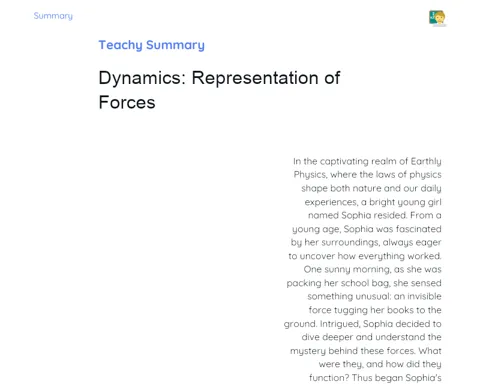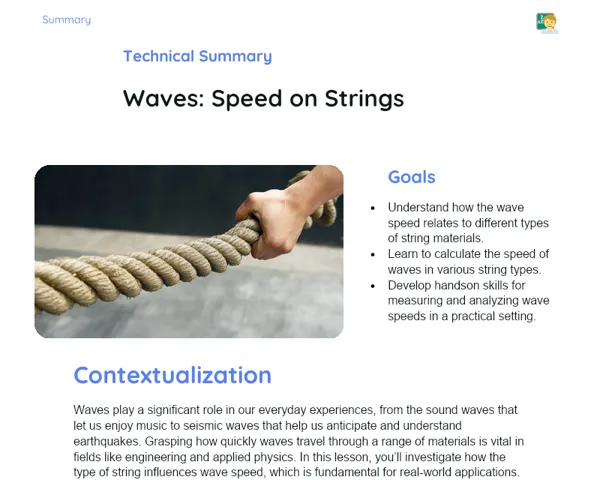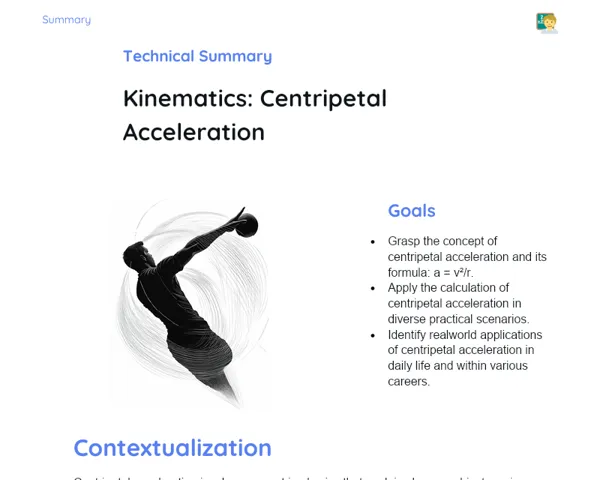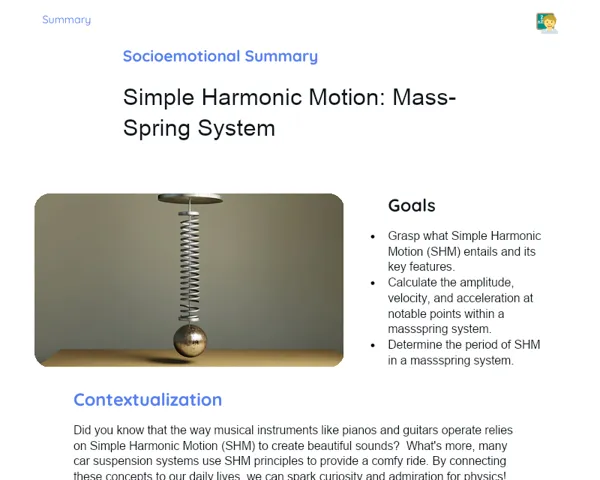Socioemotional Summary Conclusion
Goals
1. 🤔 Grasp the concept of work done by a constant force and its formula: W = F * d * cos(θ).
2. 💡 Calculate the work done by a constant force in various real-life scenarios.
3. 🤖 Link theoretical knowledge to everyday experiences, making learning meaningful and applicable.
4. 😊 Acknowledge and regulate emotions while solving physics problems, utilising the RULER method to build socio-emotional skills.
Contextualization
Have you ever thought about the effort your body puts into pushing a shopping trolley or lugging a backpack full of books? 😳 That's right! The term 'work' in physics encompasses more than what we usually perceive in our daily lives. Let's explore how to calculate this force and understand its relevance to our everyday experiences. Moreover, we’ll examine how our emotions affect our learning processes and how to manage them for better composure in our routine activities. 🌠
Exercising Your Knowledge
Understanding Work in Physics
In physics, work is defined as a scalar quantity that indicates the transfer of energy when a force acts on an object over a distance. The formula is W = F * d * cos(θ), where W stands for work, F for force, d for distance, and θ for the angle between the force and the direction of movement. Grasping this is key to solving everyday challenges, as we often do mechanical work without even realising it.
-
Work equals the force applied multiplied by the distance travelled in the direction of that force.
-
The formula W = F * d * cos(θ) helps us calculate work in practical scenarios.
-
Work can be positive, negative, or zero, depending on the angle (θ) between the force and the direction of movement.
-
In the International System of Units (SI), work is measured in Joules (J), equivalent to one Newton meter (N·m).
Significance of the Angle between Force and Movement
The angle (θ) between the applied force and the movement direction plays a crucial role in calculating work. If the force perfectly aligns with the movement direction, the work done is maximised. Conversely, if it’s perpendicular, the work done is zero. This understanding is essential for optimising effort in various personal and professional tasks.
-
If θ is 0°, the force entirely supports the movement, leading to work equalling F * d.
-
If θ is 90°, the force is perpendicular to the direction of travel, resulting in zero work.
-
If θ ranges between 0° and 90°, only the component of the force along the movement direction contributes to work.
Connection between Work and Energy
When we perform work on an object, we transfer energy to it, which may increase its kinetic, potential, or thermal energy. This concept is fundamental for understanding how our physical activities impact the environment and highlights ways to enhance energy efficiency.
-
Work can show up as kinetic energy (the motion of the object) or potential energy (stored energy).
-
Understanding this link aids in applying the work concept practically in energy-efficient tasks.
-
In everyday life, when we lift an object, we transfer energy to it as gravitational potential energy.
Key Terms
-
Work: The transfer of energy through the application of force over a distance.
-
Force: A measure of interaction that alters an object's motion.
-
Distance: The space covered by the object in the direction of the force.
-
Angle (θ): Indicates the direction of the force relative to the object's movement.
-
Joule (J): The SI unit for measuring work.
For Reflection
-
How can we use our understanding of the angle between force and movement to be more effective in our daily tasks?
-
In what ways can we apply the concepts of work and energy transfer to enhance performance in sports or physical activities?
-
What strategies can help manage emotions when faced with challenges in calculations and physics problems? How could the RULER method assist in these situations?
Important Conclusions
-
🔍 The concept of work in physics is vital for grasping how force applied to an object over a distance results in energy transfer.
-
📒 The formula W = F * d * cos(θ) enables us to calculate the work of a constant force in various practical circumstances, assisting in effort optimisation.
-
✨ Acknowledging the angle between force and movement direction is crucial for measuring work efficiency.
-
⚡ There’s a direct link between work and energy, emphasizing the importance of energy efficiency in our daily routines.
-
😊 Developing socio-emotional skills, such as recognising and regulating emotions, boosts our performance in physics and other aspects of life.
Impacts on Society
The work done by a constant force is a concept that significantly influences our daily life and society as a whole. By learning to calculate and optimise work, we can enhance efficiency in tasks like moving furniture or carrying heavy items. This knowledge not only simplifies our everyday life but also helps conserve energy and minimize unnecessary effort. For instance, applying the formula W = F * d * cos(θ) lets us figure out how to organise our routines to accomplish tasks with less physical strain and greater effectiveness.
Additionally, understanding work in physics has far-reaching implications in society, particularly in technology and engineering. The principles of work and energy are foundational for creating efficient machines, constructing infrastructure, and innovating across various fields. When we learn how to optimise work, we contribute to developing sustainable technological solutions that improve quality of life and support economic and environmental progress. This makes mastering this subject not only relevant but essential for a greener and more sustainable future. 🛰️💡
Dealing with Emotions
To manage your emotions while exploring the concept of work in physics and its applications, I recommend a reflection exercise using the RULER method. First, take a moment to calm down and identify your emotions when grappling with physics issues. You might experience feelings of frustration, anxiety, or perhaps even excitement. Next, consider what triggers these emotions: Is it the difficulty of the calculations or the pressure to perform well? Name these emotions accurately and reflect on how you express them while studying. Lastly, regulate these emotions by employing strategies like regular breaks, deep breathing, and seeking assistance when necessary. Doing so not only aids your academic success but also contributes to your emotional well-being. 🌠
Study Tips
-
📚 Practice consistently: Regularly engage with physics problems to reinforce your understanding of work and its formulas.
-
✏️ Take organized notes: Maintain a tidy notebook with formulas, examples, and explanations to ease revision.
-
🌍 Practical applications: Try to relate the concept of work to situations in your daily life to make learning more significant and memorable.



